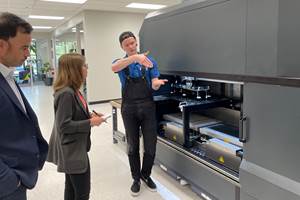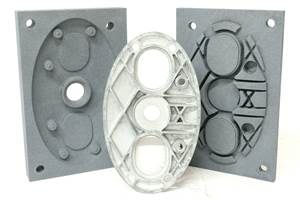Blending Rapid Tooling with Conventional Moldmaking
Rapid tooling is a good fit for a many prototype tools and a growing number of production tools.
With emerging rapid tooling (RT) technologies and increasing demands being placed upon toolmakers, the issues of if and when to use RT is becoming a critical topic in the manufacturing community. The world of conventional toolmaking is faced with mounting problems, such as increased local and foreign competition. There also is added tension from customers who demand that tools be produced faster than what was considered "good" just a few years ago. Another source of frustration the shrinking pool of skilled labor available, coupled with fewer workers entering the toolmaking field. For these reasons the industry is turning toward RT. For the purposes of this article, the term rapid tooling does not include tooling generated from CNC or traditional metal removal techniques.
When considering rapid tooling, it's necessary to keep an open mind: there is always apprehension involved when a process is new and different. Many in the toolmaking field view RT as unknown, unproven and risky. Although not all RT methods are fully proven and commercialized, many techniques are fully capable of filling a need if the criteria are a good fit.
Any discussion of rapid tooling processes must begin with a realization that each process has its own unique set of advantages and disadvantages. Rapid tooling is not only a process change, but also a philosophy change. With this in mind, willing toolmakers must realize that some of their basic assumptions about the tool-building process must be altered. As an example, consider a customer who wants to modify the part design soon after the preliminary tool design has been approved. In the traditional tool shop the change is most likely easy to integrate. The steel has been ordered and may even be in production, but usually the part geometry is not completed. The same example being applied to RT causes a different situation. If the tool cavities are being made through 3D Systems "LaserForm A6," then the first stage is to build the "green" cavities and cores on the Selective Laser Sintering (SLS) machine. In this example the most critical stage of the tool is created first and any changes could be costly. For this reason the communication and contact with the customer are integral to the success of many RT projects. Many details such as shrink rates and engineering changes need to be determined as early in the process as possible. This can be a challenge since many of the best applications are fast turnaround prototype tools.
Multiple RT Processes
No single RT process suits all goals or needs. For this reason there is
a constant search for both new processes and the improvement of
existing processes. In almost all cases, new RT methods must be
evaluated. It has been found that some are immature or not fully
"dialed in." Occasionally a new process will meet or exceed user needs
or show improvement over a similar technique.
The following three processes illustrate how varied RT methodology can be used to match individual needs.
Development tooling: This rapid tooling technique is the fastest
and generally lowest cost tooling solution. Benefits include delivery
ranging from one to three weeks and tool life of at least 50 to 200
parts.
Mid-range tooling: This type of tooling offers a fast turnaround
and consistent tool tolerance. It offers delivery in two to five weeks
and a tool life ranging from 200 to 10,000 parts.
Low-volume production tooling: This tooling method serves as a
production tool for less demanding applications. Delivery is from four
to six weeks and tool life varies from 10,000 to 100,000 parts.
In order to decide how to match a tooling project with a tooling process, each part must be evaluated and measured by specified criteria. The general criteria to exact a method are: part size, part geometry, part tolerance, plastic material, number of shots required and delivery demands.
Today's RT Situation
There is little doubt that today's rapid tooling technologies are still
in a state of adolescence. Although a few skilled companies have worked
through the learning curve and are using RT on a commercial basis, most
companies are reluctant to rely on it for other than testing or
sporadic projects. The fact is RT can already be a good fit for a large
percentage of prototype tools and a growing number of production tools.
Through hard work and determination, RT processes are maturing but many difficulties still remain. To master the use of RT, a unique set of qualities must be present. Successful users must have the knowledge and experience of 3D solid modeling, rapid prototyping and toolmaking and then be able to blend them all with the skills of an artisan.
Below is a list of general strengths and weaknesses of current RT processes. While not all of the current methods share every strength and weakness, it is fair to say that they will share the majority of the characteristics.
Rapid Tooling Strengths
Speed: Most RT processes can provide an increase in speed over
conventional tooling methods, however this is mostly true on smaller
and more complex geometries. For example, a typical core geometry that
includes extensive ribs and bosses typically will take many operations
including CNC programming, CNC milling and EDM. However if the same
core fits into the qualifications for RT, then it can easily be built
in one operation.
Cost effectiveness on complex tooling: The
processes lend themselves more to complex geometries that would be
difficult to manufacture traditionally. This is partly due to the high
costs of equipment required for the RT techniques.
Automation: Many of the RT processes are highly automated. This
means that the users can run the equipment and build tooling sets 24
hours a day, seven days a week including holidays. Thus, the
productivity of the RT process, as well as the whole shop, is improved.
Automated RT techniques can produce a greater output than either the
size of your shop or your manpower will conventionally allow.
Human Error: RT processes eliminate a certain amount of human
error found in conventional toolmaking processes. By automating the
cavity and core building process to build directly from the original
solid model, human error can be reduced. Examples can range from the
misinterpretation of blueprints, to incorrect and inaccurate setups on
a CNC mill.
Building Multiple Cavity/Core Sets: Additional cavity and core
sets can be built with a first set at a reduced cost. Sharing overhead
costs on either multiple cavity or multiple customer projects can
increase the cost effectiveness of many tooling projects.
Creative Design Possibilities: RT techniques share the
uniqueness of being created by unconventional means. This enables a
design that can be custom tailored to take advantage of the build
process advantages. An example of this would be to integrate conformal
cooling channels into a complex core design. The possibilities are not
limited to creating a design that is manufacturable with traditional
techniques.
Rapid Tooling Weaknesses
Accuracy:Most RT processes have a best case tolerance of
approximately +/-.005" to +/-.010" range. It is standard procedure to
design extra stock on critical dimensions and seal off conditions to be
tuned in traditionally. However, this extra step can hinder the
effectiveness of the process.
Cost Effectiveness: The cost of materials and equipment has
created a high overhead associated with most RT techniques. This can
quickly rule out many projects if they are relatively easy to produce
conventionally.
Size Limitations: Many of the rapid tooling methods are limited
in the physical size of inserts that can be effectively created. Most
processes have a maximum cavity size of less than 10 square inches.
Tool Life: Most RT options have a limitation of tool life due to
the materials of the cavity inserts. This can be affected by the end
product material and possibly enhanced by surface coatings or
treatments. This can be an important criterion for selecting a RT
process.
Investment in equipment: RT techniques generally require a significant investment in capital equipment if a company wants to perform the work in-house.
The Future of Rapid Tooling
As development progresses in the area of rapid tooling, the existing
processes will continue to eliminate weaknesses and improve strengths.
While this is taking place, new methods are continually being explored,
offering the possibilities of even more excitement. As this future
becomes reality, these new methods will further enhance the usefulness
and acceptance of RT into the toolmaking community. While the industry
also is changing and becoming more competitive, RT should not be seen
as an enemy. It should be viewed as another weapon in our arsenal for
becoming better toolmakers. This can be equally as important for the
large OEM trying to get their product to market faster and the small
mold shop fighting to compete.
Related Content
Additive Manufacturing's Evolving Role at Fathom Now Emphasizing Bridge Production
Bridge production is currently the biggest opportunity for additive manufacturing, says Fathom Manufacturing co-founder Rich Stump. How this service provider leverages AM while finding balance with other production capabilities.
Read MoreIndyCar's 3D Printed Top Frame Increases Driver Safety
The IndyCar titanium top frame is a safety device standard to all the series' cars. The 3D printed titanium component holds the aeroscreen and protects drivers on the track.
Read MoreFoundry Lab: How Casting in a Day Will Improve the Design of Metal Parts (Includes Video)
The company’s digital casting process uses 3D printing, but the result is a cast part. By providing a casting faster than a foundry, the company says effective prototyping is now possible for cast parts, as well as bridge production.
Read MorePlastics Assembly Expert Joins Development and Production via 3D Printing
Manufacturing technology supplier Extol has always served customers who are producing polymer parts. Now, it is making some of those parts in-house through 3D printing, providing new options ranging from functional prototyping into bridge production and beyond.
Read MoreRead Next
3D Printing Brings Sustainability, Accessibility to Glass Manufacturing
Australian startup Maple Glass Printing has developed a process for extruding glass into artwork, lab implements and architectural elements. Along the way, the company has also found more efficient ways of recycling this material.
Read MoreHybrid Additive Manufacturing Machine Tools Continue to Make Gains (Includes Video)
The hybrid machine tool is an idea that continues to advance. Two important developments of recent years expand the possibilities for this platform.
Read MoreAt General Atomics, Do Unmanned Aerial Systems Reveal the Future of Aircraft Manufacturing?
The maker of the Predator and SkyGuardian remote aircraft can implement additive manufacturing more rapidly and widely than the makers of other types of planes. The role of 3D printing in current and future UAS components hints at how far AM can go to save cost and time in aircraft production and design.
Read More




















